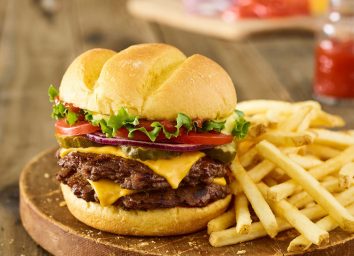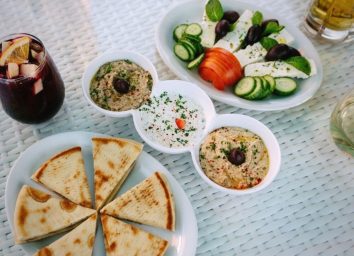
Just like fashion, food trends come and go on a whim. Once you've got a taste for the craze, the world is already moving on to the next big thing. We've seen fondue, wine coolers, cake pops, and shrimp cocktails served in martini glasses get their moment in the sun before fading off the menu.
The new "it" food is sometimes touted as being a healthy new "superfood," or the novelty could be about the cooking technique or dining experience. It seems that each year, we pick something new we love, and then we demand more of it. Eventually, however, all food fads settle into obscurity, losing their power on social media and status on supermarket shelves.
Here are our favorite food "fails" from the past years we'd rather not revisit. From gluttonous obsessive fixations to weird pseudo-science health crazes, these food fads shall not be missed.
And don't miss The Most Popular Steakhouses in America, According to New Data.
Raw Vegan Food
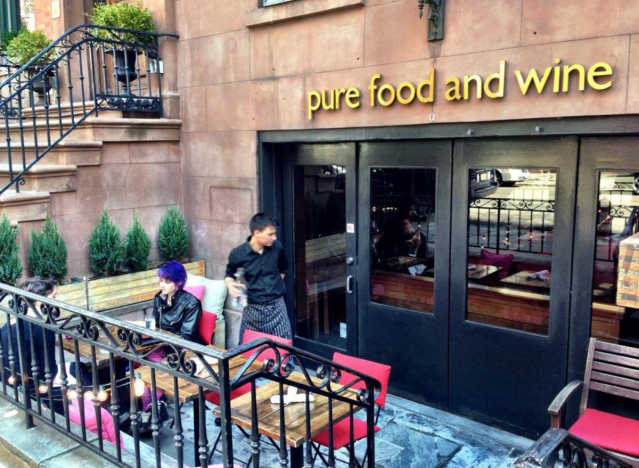
A movement that took hold in California in the 1960s, raw veganism got a second wind when it started making headlines thanks to notable celebrities who endorsed it in the mid-2000s. While some see it as the final level of ascension in a meatless life, others have claimed the fad is blown up with pseudoscience and lacking in essential vitamins.
Regardless of how you feel about heating your food past 104 degrees (touted as the heat level responsible for destroying essential elements of food), the fervor for "rawism" began to pop up in magazine pages, on talk shows, and in the health news as the 19th century gave way to the millennium. Here, raw veganism became the lifestyle of the rich and famous.
As featured on Netflix's new crime docuseries Bad Vegan, many celebrities were dining at New York's trendy Pure Food and Wine restaurant—one of the first establishments to champion the trend in New York City. Woody Harrelson, Alec Baldwin, and Alicia Silverstone could be seen there enjoying dishes like the Zebra Tomato and Zucchini Lasagna coupled with a Master Cleanse Tini made with organic sake, lemon juice, maple syrup, and cayenne pepper.
While the show made it clear that the restaurant's ultimate demise had less to do with raw veganism losing popularity than the illegal transfer of over $1.5 million in funds from the business into the owner's personal account—the bad press didn't help the movement's image, which thrived as much on activism and social responsibility as it did on its health claims.
Just as many ultra strict health trends go, the allure of raw veganism reached critical mass before tapering off as another diet craze gone to make room for the next one.
Dining in the Dark
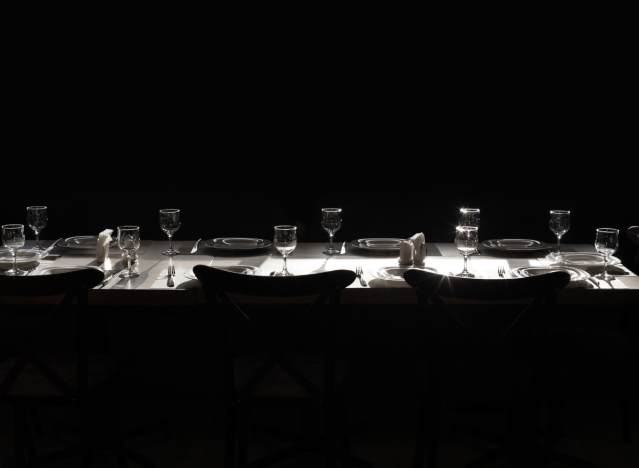
There is a certain element of trust involved in blindly eating food someone has handed you. In the mid-2000s, however, that was part of the allure of the dining in the dark craze.
First launched in Paris in 1997, dining in the dark began as a social experiment to get people to understand blindness not only as a disability but as offering a livable, fully satisfying life. The experiment eventually switched from a program to a permanent restaurant in 1999 in Zürich, Switzerland. Operated by a blind clergyman, diners at restaurant Blindekuh reported that the experience heightened their senses and allowed them to gain greater enjoyment of their meal.
By the early to mid-2000s, more and more restaurants began opening to diners without the lights on. Many of these sightless dinner experiences featured wholly dark dining rooms, rather than blindfolded customers. Because the logistics of waiting tables in the complete dark proved cumbersome, many of these establishments would hire waiters with visual impairments, who were more adept at navigating a room without seeing it.
However, a regular complaint about these establishments was that once the newness of dining in the dark wore off, the actual food at many of these restaurants ended up being rather unspectacular. As of recently, one of the last two notable dark restaurants in the United States, Opaque in West Hollywood, has shut down. Those still interested in a shadowy supper can seek out Blackout in Las Vegas. Or perhaps, just opt for forgoing the electric bill at home.
Bacon Everything
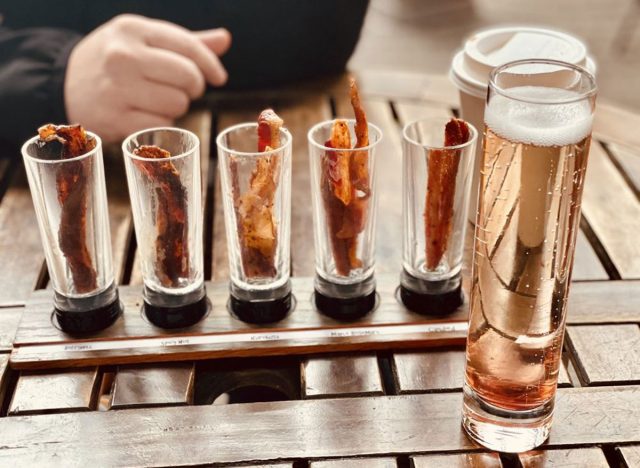
As the internet transformed from an "information superhighway" to a daily social gathering place at the turn of the millennium, memes started making virial trends a reality. One such trend was simply called "Bacon Mania" and it gripped the nation with a fervor for fatback.
Using bacon as an accouterment for every possible dish was in part hyped by the popularity of the Atkins Diet and other low-carb diets. Thought of as the secret to shedding pounds while gorging oneself on once forbidden fats, eating meat never looked better.
The overuse of bacon soon ballooned beyond low carb, however, as restaurant kitchens and bars started sending out chocolate-covered bacon, bacon-infused vodka, and bacon salt. The internet added fuel to the fire and bacon soon left the pan to join other marketing efforts. Soon you could buy bacon-shaped bandages, air fresheners, rolling papers, and even an alarm clock that would wake sleepers with the smell of bacon. Bacon had reached new incarnations as our fanaticism for the crispy swept the nation.
Bacon-themed restaurants and specials became prevalent in the culinary world, including Burke's Bacon Bar in Chicago, Kensington Bacon Nation in Toronto, and Bacon Bacon in San Francisco. While bacon as a food substance isn't likely to go out of style, the Swine flu pandemic of 2009 didn't help the "bacon as a way of life" mentality of the 2010s. So, as do many internet fads—bacon went back to being a side order rather than the main event.
Molecular Gastronomy
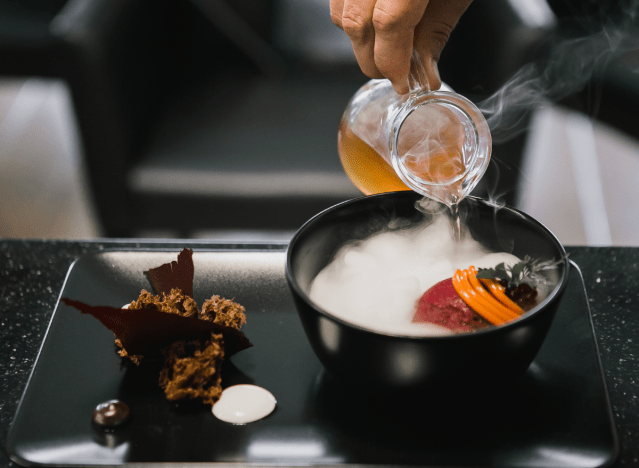
A trend limited to highbrow fine dining in the early 2000s, molecular gastronomy relied on performative plating and the "science" behind the food. Haute chefs initially used the techniques to transform textures, flavors, and forms by using new tools and ingredients more frequently found in labs than kitchens. While these imaginative rule-breakers introduced the techniques of molecular gastronomy in cooking, the trend soon became exploited into pretense over taste.
For most people today, however, a Frankenstein meets Julia Child approach isn't top of the list when it comes to dinner options. Edible foams, fogs, and forms not of this planet seemed to have gone the way of the waterbeds and bouffants as diners realized they just wanted something recognizable. WD-50, one of the most notable molecular gastronomy restaurants in New York, closed in 2014, making it seem as though even the trendiest of Americans may have hung up their lab coats on the trend.
Whether or not nitrogen flash-frozen foods or parmesan foam might make a comeback is up to the future foodies to decide, but many chefs are actually relieved. According to an interview with Mashed, Top Chef's Tom Colicchio, said of molecular gastronomy, "thank god that's gone."
Deconstructed and Plate-less
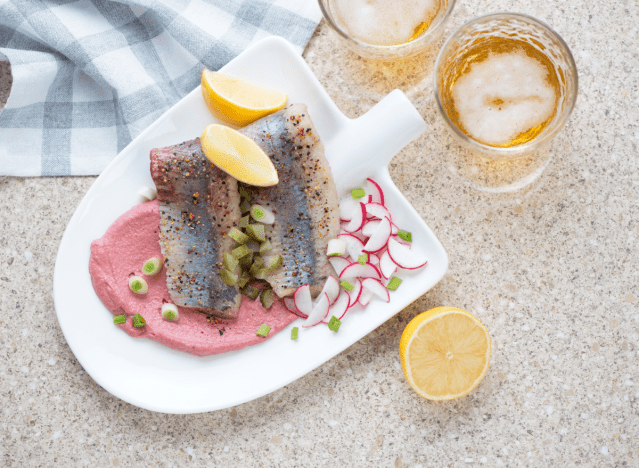
"Deconstructed" dishes, or ones being served on something other than a traditional plate, had their moment. But the trend disappeared almost as quickly as it had appeared. Deconstruction was a spin-off from the molecular gastronomy movement, which disassembled traditional dishes and reassembled them into something entirely different from their origins.
"Plate-less" foods, on the other hand, grew as Instagram became more mainstream and "foodie" pictures gained momentum. Restaurants started looking for new ways to promote their dishes and found that an easy way to add interest to a plate is to serve it without one. Instead, food was served in things like driftwood, martini glasses, fry baskets, on digital images of plates, the customer's own hands, and even in one half of a dust bin. For many trendy restaurants at the time, there was no limit to the imagination of what a plate could be.
However, Twitter and Reddit unleashed their fury during the height the fad. Twitter decided that it had had enough when a San Francisco tech journalist jokingly posted about "deconstructed avocado toast" being served in Venice Beach. Backlash erupted, calling the dish a salad. Reddit even has a community r/WeWantPlates, which "crusades against serving food on bits of wood, roof tiles, chips in mugs and drinks in jam jars." OPs ridicule dishes served on objects, document experiences, and vent frustrations about the trend. Since the internet backlash, restaurants have toned down the fad of photo-op food — least they make an unwelcome appearance on the internet. While most can't say we miss putting together their own burgers or dining out of a fishbowl, the pictures were pretty neat.
